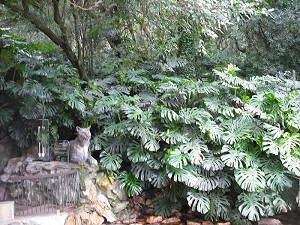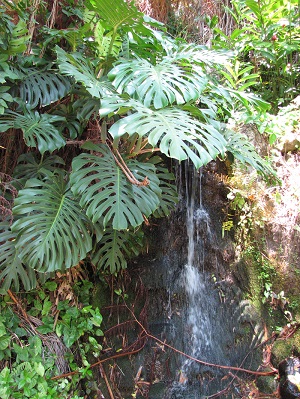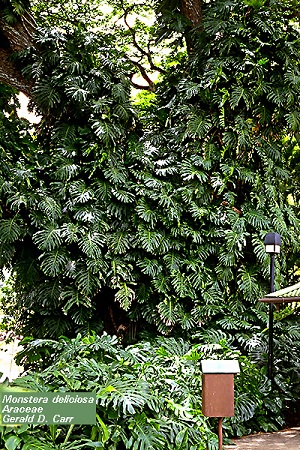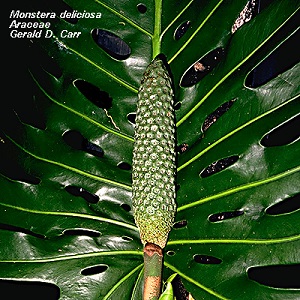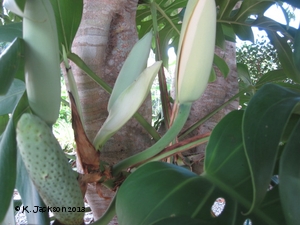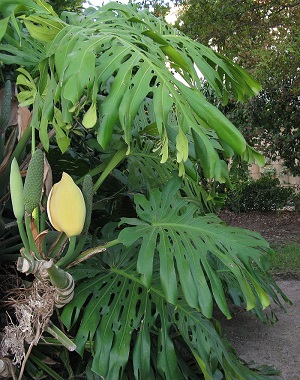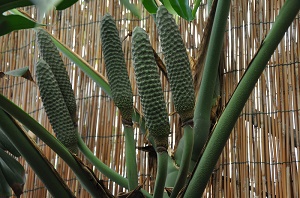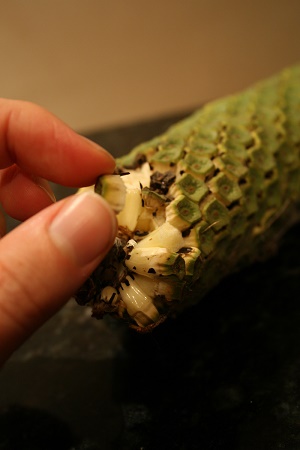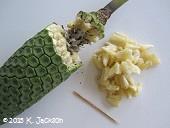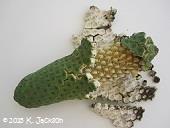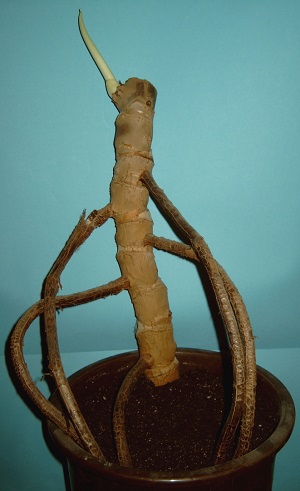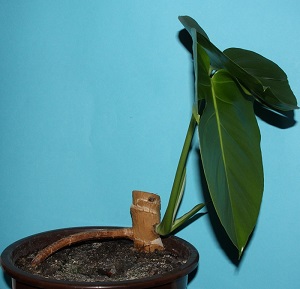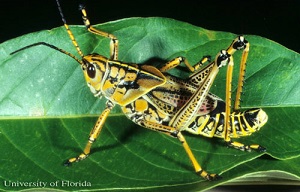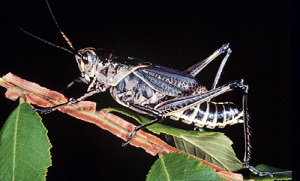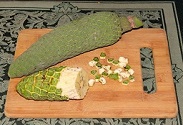| Monstera, Ceriman - Monstera deliciosa | |||||||||||||||||||||||||||||||||||||
|---|---|---|---|---|---|---|---|---|---|---|---|---|---|---|---|---|---|---|---|---|---|---|---|---|---|---|---|---|---|---|---|---|---|---|---|---|---|
 Fig. 1  Monstera deliciosa 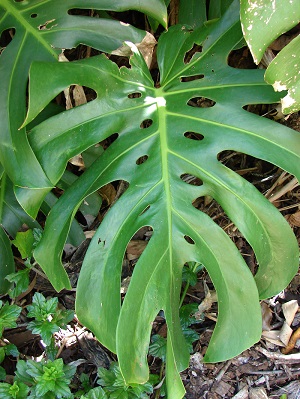 Fig. 2   Fig. 3 Underside of leaf 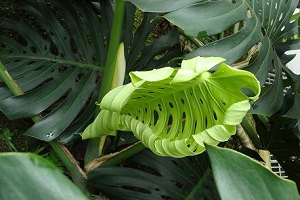 Fig. 4  New leaf emerging 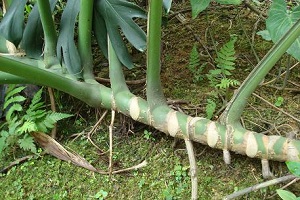 Fig. 5  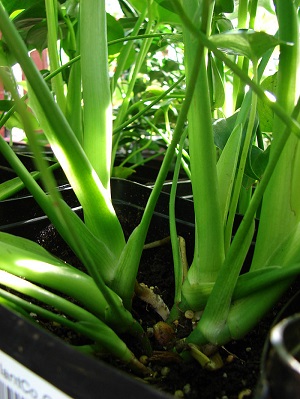 Fig. 6  M. deliciosa (habit). Maui, Lowes Garden Center Kahului, Hawai'i. 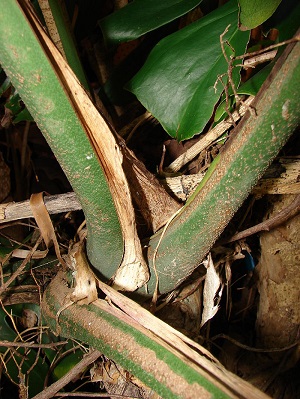 Fig. 7  M. deliciosa (stems). Maui, Makawao, Hawai'i. 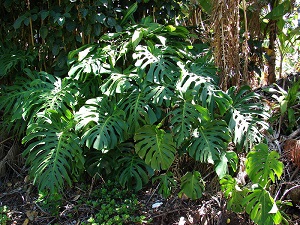 Fig. 8  M. deliciosa (habit). Maui, Makawao, Hawai'i. 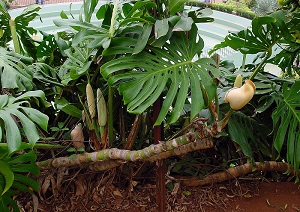 Fig. 12  Monster fruit, Monsterio Delicio, Monstereo, Swiss cheese plant or Mexican breadfruit 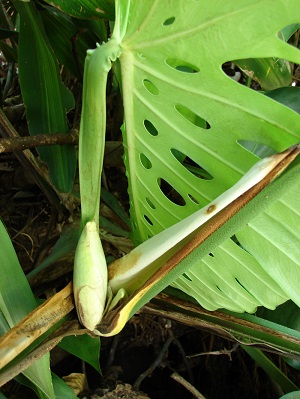 Fig. 13  M. deliciosa (Swiss-cheese plant) Flower. Makawao, Maui, Hawai'i. 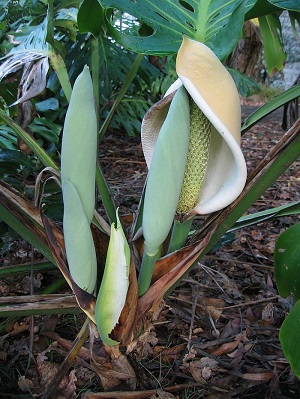 Fig. 14  Flower and buds of M. deliciosa, in the grounds of Old Government House, Auckland 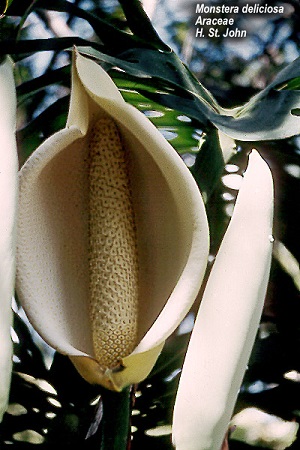 Fig. 15  Waxy, white spather that later drops 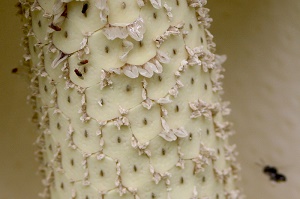 Fig. 16  M. deliciosa, cultivated, Townsville - close-up of fresh flower, with tiny flies and (out of focus at lower right) a native bee (Trigona sp. or similar) attracted to it. The background of the photo is the flower's hood. 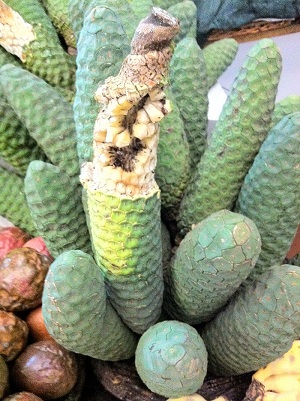 Fig. 17  Self peeling bananas, taste like pineapples. Funchal Public Market. 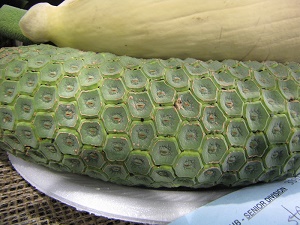 Fig. 18  M. deliciosa (Swiss-cheese plant). Fruit on display. Maui County Fair Kahului, Hawai'i.  Fig. 19  M. deliciosa: ripened fruit with inside details  Fig. 32 Adult lubber grasshopper in light color phase 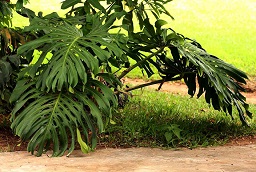 Fig. 36  |
Scientific
name Monstera deliciosa Liebm. Pronunciation mawn-STEER-ruh dee-liss-see-OH-suh 3 Common names English: cut-leaf-philodendron, fruit-salad-plant, Mexican-breadfruit, monstera, Swiss-cheese-plant; French: cériman; German: großes Fensterblatt, Philodendron; Portuguese: banana-de-macaco, banana-do-brejo, banana-do-mato; Spanish: balazos, harpón, piñanona monstera; Swedish: monstera. 6 Synonyms M. borsigiana Engl.; M. deliciosa var. borsigiana (Engl.) Engl. & K. Krause; M. deliciosa var. sierrana G. S. Bunting; M. lennea K. Koch; M. tacanaensis Matuda; P. anatomicum Kunth 5 Relatives M. lechleriana, M. friedrichsthalii, M. dissecta, and M. pertusa (all ornamental houseplants). Numerous Philodendron species including the common landscape plant P. bipinnatifidum Family Areacea Origin Native to wet forests of southern Mexico, Guatemala and parts of Costa Rica and Panama 2 USDA hardiness zones 10-11 Uses Landscape, fruit Height May exceed 70 ft (21 m) in length if left unpruned Plant habit Herbacious vine Growth rate Fast growing Trunk/bark/branches Usually one very thick stem (Fig. 3) 4 Pruning requirement Can become very large if they are not cut back to contain their size 2 Leaves Alternate, simple, lobed, ovate; 3-4 ft high (0.9–1.2 m), evergreen, oblong holes (Fig. 6), deeply notched margins (Fig. 5) Flower Tiny, perfect: both male and female Fruit Spadix made up of numerous cohering berries; rind has tile like hexagonal scales; pulp off-white, juicy, sweet Season June through October; the fruit can take a year or longer to ripen 4 Light requirement Light shade (filtered sunlight) 2 Soil tolerances Sligntly alkaline; clay; sand; acidic; loam 4 Drought tolerance Moderate Flood tolerance Not tolerant of flooded or excessively wet soil conditions 2 Soil salt tolerance Poor Cold tolerance Leaves are damaged or killed at 30-32 °F (-1.0-0 °C); stems at 26-28 °F (-2 to- 3 °C) 2 Plant spacing 20 or more ft (6.1 m or more) away from trees and other plants and electrical poles 2 Roots Long, aerial, tentacle-like roots taking root when they touch the ground 2 Invasive potential * Not known to be invasive Pest resistance Not usually affected by pests Known hazard All parts of the plant are poisonous; unripe fruit contains irritating calcium oxalate crystals Reading Material Monstera Growing in the Florida Landscape, University of Florida pdf Ceriman, Fruits of Warm Climates Monstera, University of Hawai'i at Mānoa pdf Ceriman, Delicious Monster, Eat the Weeds Origin Monstera is indigenous to the hot, humid, tropical forests of Mexico, Guatemala, Costa Rica, and Panama. 2 Description Monstera is a fast growing broadleaf vine with a cylindrical, thick stem 2 to 4 inches (5–10 cm) in diameter that may grow along the ground or, if allowed, will climb onto trees and structures. The vine may exceed 70 ft (21 m) in length if left unpruned. The vine stem is covered with leaf scars from previous leaves and from it develop numerous, long, cord-like aerial roots. Left uncontrolled, the vine may be somewhat invasive i.e., take over the landscape or climb trees. 2
Fig. 9. Philodendron species can be found in many diverse habitats in the tropical Americas and the West Indies Fig. 10. M. deliciosa (Swiss-cheese plant). Habit and water feature. Iao Tropical Gardens of Maui, Maui, Hawai'i Flowers The bloom of Split-Leaf Philodendron is a 12-inch-long, white, calla-like spadix and it is sometimes followed by the unusual, edible fruit which tastes much like a cross of pineapple and banana. The fruit can take a year or longer to ripen, but only under the exacting conditions of proper warmth, high humidity, and bright light typical of USDA hardiness zone 10. 4 Flowering and fruiting overlap because it requires 12 to 14 months from the opening of the inflorescence to the maturity of the fruit. Therefore, there are often unopened inflorescences, immature fruits and ripening fruits together on the same plant. The current year's crop is ripening through summer and fall while the following year's crop is forming beside it. 1 Fruit The fruit is called a spadix and is made up of numerous cohering berries. At first the spadix is sheltered by a waxy, white, spathe (bract) (Fig. 13) that later drops off. The compound fruit is cylindrical, green, 8 to 14 inches (20-36 cm) long and 2 to 3 1-2 inches (5-9 cm) in diameter. The peel is thick, hard, and made up of hexagonal plates (scales) that cover individual segments of ivory colored, juicy, flavorful pulp. Among the fruit segments are small, black particles which are the remnants of flowers. Generally, there are no seeds, although sometimes small, pale-green seeds are produced. 2 The fruit or Ceriman will grow even without pollination, about 25 cm (10) long. Immature fruit (green) contains calcium oxalate which is toxic. The fruit should not be consumed before maturity (yellow) (Fig. 25).
Fig. 21. Different stages of fruiting Fig. 22. Note the dead cataphyll at the leaf petiole, plus the dead spathe around one spadix Fig. 23. Fruiting habit Fig. 24. M. deliciosa. We have a plant in our new house. Didn't know if it was edible at first. Yum. Fig. 25. M. deliciosa: ripened fruits with inside details Close up series of the ceriman fruit
Varieties Few named monstera varieties exist. There are a number of varieties with variegated leaves including ‘Variegata’, ‘Albovariegata’, and ‘Marmorata’; however, the quality of their fruit is not known and they may be hard to find in the nursery trade in Florida. Caution: these varieties may not have edible fruit. 2 Harvesting Mature fruit ready to harvest turn from green to a lighter green and the tile-like segments at the base of the fruit begin to separate slightly, making it appear somewhat bulged. Fruit may then be cut from the plant, leaving 1 inch or more of the stem. To ripen the fruit, it keep it at room temperature (78-82°F; 26-28°F) for 5 to 6 days during which time it will ripen from the base toward the apex (top). The pulp should only be eaten from that portion of the fruit that easily falls off the core (stem). This is because immature sections of the fruit contain oxalic acid crystals that cause severe discomfort when swallowed. 2 Propagation Propagation is by means of stem cuttings, which may be simply set in beds or pots in the ground where the vine is intended to grow. Suckers or offshoots, with or without roots, can be separated from parent plants and transplanted successfully. Plants generated from cuttings may come into bearing in 4 to 6 years, whereas suckers begin fruit production in 2 to 4 years. 2
Fig. 30. M. deliciosa (Windowleaf), stem cutting with fresh sprout Fig. 31. New growth on small stem cutting Cultural Practices, University of Florida Planting Dig a hole 3 to 4 times the diameter and 3 times as deep as the container the monstera vine came in. Making a large hole loosens the soil next to the new vine, making it easy for the roots to expand into the adjacent soil. It is not necessary to apply fertilizer, topsoil, or compost to the hole. 2 Fertilizing Monstera fertilizer requirements do not appear to be high. After planting, when new growth begins, apply ¼ lb (113 g) of a complete dry fertilizer mix with 20 to 30% of the nitrogen from organic sources. Micronutrient applications should be made 2 to 3 times per year, generally during the growing season. Iron should be applied in a chelated formulation. 2 Irrigation Although monstera vines are moderately drought tolerant, especially when grown in the shade, periodic watering during dry periods will result in better growth and larger fruit. 2 Pests When grown indoors, the plants are subject to infestation by scale insects, mites and mealybugs. Outdoors, they are usually pest-free. However, in dry seasons in Florida, the lubber grasshopper (Romalea microptera) has rapidly consumed entire leaves, leaving only the base of the midrib and the petiole. In India, wire cages are placed around developing fruits to protect them from rats, squirrels, monkeys and other creatures.
Fig. 33. Adult lubber grasshopper in intermediate color phase Fig. 34. Adult lubber grasshopper in dark color phase Eastern Lubber Grasshopper, Romalea microptera (Beauvois), University of Florida pdf Diseases The following diseases have been recorded in Florida: leaf spot caused by Leptosphaeria sp., Macrophoma philodendri, Phytophthora sp., and Pseudomonas cichorri; anthracnose from Glomerella cingulata; bacterial soft rot from infection by Erwinia carotovora; and root rot caused by Pythium splendens and Rhizoctonia solani. Toxicity The oxalic acid, and possibly other unidentified principles, in the unripe fruit, the floral remnants of the ripe fruit, and all parts of the plant, cause oral and skin irritation. Some sensitive individuals claim that even the ripe fruit irritates the throat. It would be well to avoid eating the ceriman in quantity until it is determined that there are no undesirable reactions. Some individuals have experienced urticaria and anaphylaxis after eating ceriman. Some children and adults have reported diarrhea and intestinal gas after consuming the flesh or products made from it. 1 Food Uses Fully ripe pulp is like a blend of pineapple and banana. It may be served as dessert with a little light cream, or may be added to fruit cups, salads or ice cream. 1 In general, monstera is eaten as a fresh fruit, although the pulp may be used as an ingredient in desserts. The fruit contains large amounts of oxalic acid, and it is not recommended to eat large quantities of this fruit at any one time. 2
Fig. 35. M. deliciosa, cultivated, Townsville - whole mature fruit and cut fruit Medicinal Properties ** In Mexico, a leaf or root infusion is taken daily to relieve arthritis. A preparation of the root is employed in Martinique as a remedy for snakebite. 1 Other Uses The aerial roots have been used as ropes in Peru. In Mexico, they are fashioned into coarse, strong baskets. 1 Further Reading The Monster in Your Garden, Tropical Fruit News, RFCI List of Growers and Vendors |
||||||||||||||||||||||||||||||||||||
| Bibliography 1 Fruits of Warm Climates. Julia F. Morton, Miami, 1987. 2 Crane, Jonathan H., and Carlos F. Balerdi. "Monstera Growing in the Florida Home Landscape." edis.ifas.ufl.edu. This document is HS1071, one of a series of the Horticultural Sciences Department, Florida Cooperative Extension Service, Institute of Food and Agricultural Sciences, University of Florida. Original publication date Feb. 2005. Revised Nov. 2016. Reviewed Dec. 2019. Accessed 29 Dec. 2016, 12 Apr. 2020. 3 Deane, Green. "Ceriman, Delicious Monster." Eat the Weeds and other things, too. eattheweeds.com. Web. 12 Feb. 2015. 4 Gilman, Edward F. "Monstera deliciosa." edis.ifas.ufl.edu. This document is Fact Sheet FPS-414, one of a series of the Environmental Horticulture Department, Florida Cooperative Extension Service, Institute of Food and Agricultural Sciences, University of Florida. Publication Oct. 1999. Archived. Web. 12 Feb. 2015. 5 "Monstera deliciosa Liebm." The Plant List (2010). Version 1. theplantlist.org. Web. 29 Dec. 2016. 6 "Taxon: Monstera deliciosa Liebm." USDA, Agricultural Research Service, National Plant Germplasm System. 2018. Germplasm Resources Information Network (GRIN-Taxonomy). National Germplasm Resources Laboratory, Beltsville, Maryland. npgsweb.ars-grin.gov/gringlobal/taxonomydetail.aspx?id=24556. Accessed 5 Sept. 2018. Photographs Fig. 1 Maguire, Ian. Monstera deliciosa. Tropical Fruit Photography Picture Archive. trec.ifas.ufl.edu. Web. 13 Feb. 2015. Fig. 2,3 Starr, Forest and Kim. Monstera deliciosa (Swiss-cheese plant). 2008. Lowes Garden Center Kahului, Maui. starrenvironmental.com. (CC BY-SA 3.0). Web. 12 Feb. 2015. Fig. 4,5 Kwan. Monstera deliciosa. 2008. natureloveyou.sg. Web. 12 Feb. 2015. Fig. 6,8 Starr, Forest and Kim. Monstera deliciosa (habit). 2008. Makawao, Maui, Hawai'i. starrenvironmental.com. (CC BY-SA 3.0). Web. 2 Jan. 2017. Fig. 7 Starr, Forest and Kim. Monstera deliciosa (stems). 2008. Makawao, Maui, Hawai'i. starrenvironmental.com. (CC BY-SA 3.0). Web. 2 Jan. 2017. Fig. 8 Starr, Forest and Kim. Monstera deliciosa (Swiss-cheese plant) Fruiting habit. 2011. Kula Botanical, Maui. starrenvironmental.com. (CC BY-SA 3.0). Web. 12 Feb. 2015. Fig. 9 Peixoto, Rosina. Philodendron species can be found in many diverse habitats in the tropical Americas and the West Indies. 2010. commons.wikimedia.org. (CC BY-SA 3.0). Web. 2 Jan. 2017. Fig. 10 Starr, Forest and Kim. Monstera deliciosa (Swiss-cheese plant) Habit and water feature. 2012. Iao Tropical Gardens of Maui, Maui. starrenvironmental.com. (CC BY-SA 3.0). Web. 12 Feb. 2015. Fig. 11,20 Carr, Gerald,D. Monstera deliciosa, Areacea. N.d. University of Hawai'i, Botany Department, Mānoa Campus Plants. botany.hawaii.edu. Web. 13 Feb. 2015. Fig. 12 Hagens, Wouter. Monster fruit, Monsterio Delicio, Monstereo, Swiss Cheese Plant or Mexican Breadfruit. 2001. commons.wikimedia.org. Public domain. Web. 2 Jan. 2017. Fig. 13 Starr, Forest & Kim. Monstera deliciosa (Swiss-cheese plant) Flower. Makawao, Maui, Hawai'i. 2008. starrenvironmental.com. (CC BY-SA 3.0). Web. 2 Jan. 2017. Fig. 14 Avenue. Flower and buds of Monstera deliciosa, in the grounds of Old Government House, Auckland. 2006. commons.wikimedia.org. (CC BY-SA 3.0). Web. 2 Jan. 2017. Fig. 15 St-John, H. Monstera deliciosa, Areacea. N.d. University of Hawai'i, Botany Department, Mānoa Campus Plants. botany.hawaii.edu. Web. 13 Feb. 2015. Fig. 16 Tattersall, Malcolm. Monstera deliciosa, cultivated, Townsville - close-up of fresh flower, with tiny flies and (out of focus at lower right) a native bee (Trigona sp. or similar) attracted to it. The background of the photo is the flower's hood. 2010. flickr.com. (CC BY-NC-SA 2.0). Web. 3 Jan. 2017. Fig. 17 Nash, Andrew. Self peeling bananas, taste like pineapples. Funchal Public Market. 2011. commons.wikimedia.org. (CC BY-SA 2.0). Web. 2 Jan. 2017. Fig. 18 Starr, Forest and Kim. Monstera deliciosa (Swiss-cheese plant). Fruit on display. Maui County Fair Kahului, Maui, Hawai'i. 2012. starrenvironmental.com. (CC BY-SA 3.0). Web. 2 Jan. 2017. Fig. 19,25 B. navez. Monstera deliciosa: ripen fruits with inside details. 2006. commons.wikimedia.org. GNU Free Documentation License, Version 1.2 and (CC BY-SA 3.0). Web. 2 Jan. 2017. Fig. 21 Jackson, Karen. "Monstera deliciosa Series." 2013. growables.org. JPG file. Fig. 22 Richfield, Jon. Note the dead cataphyll at the leaf petiole, plus the dead spathe around one spadix. 2011. commons.wikimedia.org. (CC BY-SA 3.0). Web. 2 Jan. 2017. Fig. 23 Stefano. Monstera deliciosa. 2014. flickr.com. (CC BY-NC-SA 2.0). Web. 3 Jan. 2017. Fig. 24 Pearson, Cris. Monstera deliciosa. We have a plant in our new house. Didn't know if it was edible at first. Yum. 2006. flickr.com. (CC BY-NC-SA 2.0). Web. 3 Jan. 2017. Fig. 26,27,28,29 Jackson, Karen "Monstera deliciosa series." 2018. www.growables.org. JPG file. Fig. 30,31 Kraft, Sönke aka zu Linden, Arnulf. Monstera deliciosa (Windowleaf), stem cutting with fresh sprout. 2009. commons.wikimedia.org. GNU Free Documentation License, Version 1.2, (CC BY-SA 3.0), (CC BY-SA 2.5), (CC BY-SA 1.0). Web. 2 Jan. 2017. Fig. 32,33,34 Capinera, John. Eastern lubber grasshopper. N.d. University of Florida. edis.ifas.ufl.edu. Web. 13 Feb. 2015. Fig. 35 Hyde, Mark, Bart Wursten and Petra Ballings. Monstera deliciosa Liebm. Crocodile Farm, Kariba, Garden, 2009-01-06, (CC BY-NC 3.0), eol.org/data_objects/19253037. Accessed 5 Sept. 2018. Fig. 36 Tattersall, Malcolm. Monstera deliciosa, cultivated, Townsville - whole mature fruit and cut fruit, 2015-05-19 21:17:33 UTC, (CC BY-NC-SA 2.0), eol.org/data_objects/24870856. Accessed 5 Sept. 2018. * UF/IFAS Assessment of Non-native Plants in Florida's Natural Areas ** Information provided is not intended to be used as a guide for treatment of medical conditions. Published 12 Feb. 2015 LR. Last update 12 Apr. 2020 LR |
|||||||||||||||||||||||||||||||||||||
